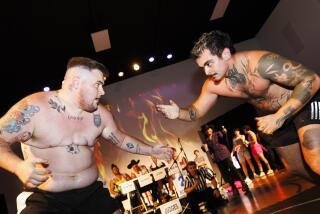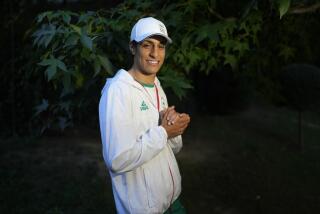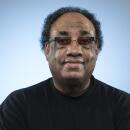Boys in the Ring : Youth activities: Burbank officials grapple with a request for a boxing facility for children, teen-agers.
The L.A. Youth Athletic Club in the old Lincoln Heights jail is a steamy and boisterous city-sponsored gymnasium frequented by children, teens and young adults--some of them fresh out of gangs from such nearby strongholds as Frogtown, Cypress, Avenues and Dog Town.
It’s not exactly the corner malt shop, and the kids hanging out there aren’t exactly playing pinball or spinning marbles. But their families maintain that they are having clean fun while learning discipline, independence and self-esteem.
Joe Hooven, a former amateur boxer and a member of the Burbank Parks and Recreation Commission, wants to bring the same opportunity to his city by building a youth center that would feature boxing, martial arts and other “non-traditional” sports. But the idea isn’t exactly flourishing. City parks and recreation officials are cool to the proposal because they say boxing is too dangerous.
The Burbank City Council has asked for more information, and in so doing has thrust city officials and recreation specialists into a sea of conflicting information about the safety of amateur boxing and its ability to reach troubled youths where other programs have failed.
The evidence ranges from medical reports to recreation experts to the likes of Johnny Flores, a 75-year-old ex-pug who runs the L. A. Youth Athletic Club.
“The kids are safe in here, they obey the rules, they’re having fun and they’re getting in shape,” said Flores, who looks at least 20 years younger than his age. “Before, there was no place for kids to go, and they got into trouble, especially the hard-core ones. Now they have a place to call their own, and they love to box.”
Flores is just one of many youth counselors, sports experts, probation workers and law enforcement officials around the country who sing the praises of boxing for children and young teen-agers, especially those from the inner city. They say it is a healthy activity that may be safer for youths than youth football or league basketball.
Police officials who work with children say boxing is also the perfect sport for troubled teens. “Sometimes you can turn a kid who would rather hang out on a street corner totally around,” said Joe Johnson, executive director of the Police Athletic League, a national recreational and educational organization of law enforcement officers that works with local parks agencies to help troubled youths.
Fans of youth boxing also say the mystique and the Hemingwayish romance of the sport has not lost its appeal after decades--the competition between two individuals standing alone with nothing but their fists and their wits. They point out that play-boxing is one of the first activities some fathers do with their sons.
But youth boxing has also taken some knocks lately.
The American Medical Assn., the American Academy of Pediatrics and noted physicians from around the country have continued their efforts to ban boxing on amateur and professional levels, saying it can lead to irreversible brain damage and other cerebral injuries. Others have warned about what they describe as an unsavory atmosphere surrounding the sport.
George L. Lundberg, editor of the Journal of the American Medical Assn., contended that there have been “many deaths in amateur boxing, though analysis may not have shown it. The notion that a paid fist is more damaging than an unpaid fist is absurd.”
Lundberg downplayed the need for research to show that amateur boxing is harmful. He said that while studies of the sport are welcome, “we’ll have to look again after a long period because there is a long lag time before brain damage shows up.”
“The people behind youth boxing are good-hearted, I believe,” Lundberg added. “They have better control of the sport than those who run professional boxing, and it’s not as sleazy. Still, a fist hitting a head is a fist hitting a head.”
Based on studies of professional boxing, Lundberg and other medical experts from the American Academy of Pediatrics have said that when a boxer is struck in the head, shock waves are sent through the fluid that encases the brain in the skull. Those pressure waves go in all directions and meet at the back of the head and can cause tiny tears and bleeding or even hemorrhaging.
However, notably absent from the debate is research into the numbers and types of injuries suffered by amateur boxers in the United States.
More than 21,390 boxers between the ages of 8 and 32 are registered with the federation, and about 11,000 of them are 18 or under. In addition, about 30,000 children between the ages of 12 and 26 are enrolled in boxing programs around the country run by the Police Athletic League.
“There hasn’t been any documentation to show that boxing is harmful for young people,” said Robert Voy, chairman of the Sports Medicine Committee for the boxing federation. “All of the studies that have been done in the past have been on professionals, with occasional amateurs mixed in with the group.”
Voy contended that all the injuries in amateur boxing are minor--nothing more serious than broken noses. “In all boxing, as in all sports, there have been deaths, but it doesn’t rank with football or even sky diving.”
The most important findings to date about health effects are expected this fall in a $1.8-million study by the Johns Hopkins University School of Public Health and Hygiene. The four-year study was commissioned by the USA Amateur Boxing Federation, the national governing organization for amateur boxing.
Walter Stewart, one of the Johns Hopkins University professors conducting the study, said more than 500 boxers between the ages of 13 and 21 from across the country were examined over four years. “Professional and amateur boxing are not the same sports,” Stewart said. “There may be risks, but we don’t know.”
In recent decades, various state and local organizations around the country have tried to ban or put heavy restrictions on youth boxing. Youth boxing was banned in the state of Connecticut during the late 1960s and early 1970s because of health concerns and high insurance rates, but was later reinstated.
The Michigan Athletic Board of Control, which regulated and supervised professional and amateur boxing, as well as professional wrestling, in 1986 considered but rejected a proposal to eliminate 10- and 11-year-old boxers from competition in that state. Board chairman Stuart E. Kirschenbaum, who advocated the ban, said he wanted to raise the minimum age to 16.
“The demands of amateur boxing pull children out of school,” Kirschenbaum said. “They start thinking about tournaments. I’m not against amateur sports, but I wanted to maintain a balance between education and sports.
“Plus, with a sport that makes you take punches to the head each night, you don’t really feel like hitting the books when you get home. I know. I boxed in medical school, and I would go home with headaches.”
But Kirschenbaum said he was unable to overcome a campaign of phone calls and letters orchestrated by the Amateur Boxing Federation and directed toward members of the Michigan board. Subsequently, the state agency turned regulation of amateur boxing in Michigan over to the federation.
However, Kirschenbaum said he believes that a new assault on amateur boxing will occur when the Johns Hopkins study is completed. “This is not over yet,” he said. “The hornet’s nest will kick up again.”
Officials with youth boxing groups insist that extensive safety precautions in the sport eliminate the danger to young people.
“In my 30 years of coaching,” said Tom Coulter, a coach for the 1988 U. S. Olympic boxing team, “I’ve seen about 3,000 to 4,000 kids and amateurs box, and the most injured they’ve gotten is a little bloody nose or a cut. It’s certainly less intimidating injury-wise than football.”
For protection, youth boxers are required to wear a form-fitted mouthpiece and a head guard. Gloves weigh 10 to 12 ounces, giving them more padding than the 8-ounce gloves used in professional boxing. Before and after each match, boxers must be examined by a ringside physician.
“There are more safety precautions taken with amateur boxing than there are in any other amateur sport,” said Johnson of the Police Athletic League.
Youth boxing advocates say the sport should be supported because it reaches out to troubled youths who might be tempted to join gangs.
“A lot of gang activity revolves around a major image,” said Kirby Eberhardt, chief of the gang violence suppression branch of the California Office of Criminal Justice Planning. “A program that is going to combat that has to take that image into consideration. Our boxing program still provides youth with that sense of machismo while giving the youth a relatively safe environment.”
One of the department’s most successful gang diversion programs is the Chino Youth Boxing Club, officials said. About 200 youths from age 8 to the mid-20s go through the program each year, said Ray Mendoza, one of the center’s directors.
“About 90% to 95% of our kids have been affected by gangs, or their siblings are in gangs, or they live in a gang neighborhood,” said Mendoza. “Being in a program like this helps take care of their aggression.”
The establishment of the L. A. Youth Athletic Club in 1976 was a major factor in decreasing gang violence in Lincoln Heights, said gym director Flores. Many participants were gang members. Now the gym is considered neutral territory.
“There were so many gangs around here, and everyone had their own turf,” Flores said. “We used to have six gang homicides here a month. When the gym came in, it took about six years for everything to calm down. Now there are no more killings. Everyone has come together through boxing. They cheer no matter where they’re from.”
The gym is run by the Los Angeles Department of Recreation and Parks. Patrick Strong, senior executive director of the facility, said the grass-roots program reached gang members who were not interested in team sports.
“We needed something different to get them, because the fathers of gang members really don’t sit around and throw the ball with them,” he said. “So they’re not good at throwing balls on traditional teams. But they can fight, and they’re good at it. If we can channel that energy constructively, hopefully they can get some mileage out of it.”
But others say troubled youths can get the same self-esteem from traditional team sports.
Mary J. Alvord, assistant director for the Burbank Parks and Recreation Department, which has recommended against allowing youth boxing, said current youth programs in the city, including football and basketball, were already meeting the needs of Burbank youths.
John Ferrell, national director of program services for the YMCA, said, “Being involved with football or baseball can accomplish the same thing for a youth. The potential for injury in boxing offsets whatever self-esteem benefits there may be.”
More to Read
Sign up for Essential California
The most important California stories and recommendations in your inbox every morning.
You may occasionally receive promotional content from the Los Angeles Times.











